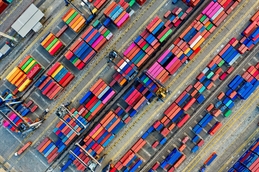
Surging container shipping cargo demand in the wake of the pandemic has resulted in a significant improvement in the global terminal capacity outlook, but this may not be sufficient to support forecast traffic levels, according to the latest Global Container Terminal Operators Annual Review and Forecast report published by global shipping consultancy Drewry.
Drewry noted that based on its annual survey, the world’s leading terminal operators are resilient to external shocks.
It said volumes, in the main, were down, but earnings less so as operators moved quickly to control costs. Capital expenditure was also reined in during 2020, but the “outlook is much improved.”
Stronger capacity outlook
Eleanor Hadland, author of the report and Drewry’s senior analyst for ports and terminals said: “The strength of the recovery in demand, aided by high levels of liquidity in the financial market, has enabled operators to bring forward their investment plans, resulting in a stronger capacity outlook post-pandemic.”
Drewry noted that global container port capacity is projected to increase by an average of 2.5% per year to reach 1.3 billion TEUs in 2025.
It added that with global demand set to rise by an average of 5% per annum over the same period, average utilization rates will increase from the current 67% to over 75%.
“While 75% utilization at a port or terminal level is not sufficiently high to be of major concern, at a global level this expectation of tightening port capacity in a market plagued by congestion due to supply chain imbalances is a cause for concern,” it continued.
The maritime research firm went on to note that the majority of the forecast additional capacity will be delivered at existing terminals, with greenfield projects still remaining a low priority for most global operators.
It said there are fewer greenfield automation projects in the pipeline, but retrofitting of existing terminals is on the rise.
The leading operators are also investing in digitalization, recognizing that this can increase the speed of movement of boxes through their facilities.
“Improving cargo flow is key,” Hadland said. “If via the roll-out of blockchain-based technology GTOs can achieve higher volumes over the same asset base, this will drive improved returns on investment.”
Looking back at 2020, the group of 21 companies classified by Drewry as GTOs, were not immune from the market challenges imposed by Covid-19, with combined equity-adjusted volumes falling 0.8% compared to a global reduction in port handling of 1.2%.
But the maritime research firm said these leading operators now handle over 49% of the global port volumes on an equity-adjusted basis, up from 45.6% in 2015.



